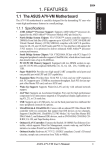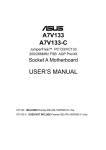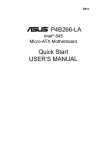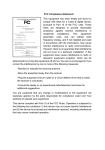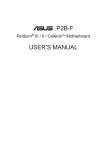Download AMD ASUS K7M-RM Athlon Slot A microATX Motherboard - K7M-RM
Transcript
R K7M-RM Slot A Motherboard USER’S MANUAL USER'S NOTICE No part of this manual, including the products and software described in it, may be reproduced, transmitted, transcribed, stored in a retrieval system, or translated into any language in any form or by any means, except documentation kept by the purchaser for backup purposes, without the express written permission of ASUSTeK COMPUTER INC. (“ASUS”). ASUS PROVIDES THIS MANUAL “AS IS” WITHOUT WARRANTY OF ANY KIND, EITHER EXPRESS OR IMPLIED, INCLUDING BUT NOT LIMITED TO THE IMPLIED WARRANTIES OR CONDITIONS OF MERCHANTABILITY OR FITNESS FOR A PARTICULAR PURPOSE. IN NO EVENT SHALL ASUS, ITS DIRECTORS, OFFICERS, EMPLOYEES OR AGENTS BE LIABLE FOR ANY INDIRECT, SPECIAL, INCIDENTAL, OR CONSEQUENTIAL DAMAGES (INCLUDING DAMAGES FOR LOSS OF PROFITS, LOSS OF BUSINESS, LOSS OF USE OR DATA, INTERRUPTION OF BUSINESS AND THE LIKE), EVEN IF ASUS HAS BEEN ADVISED OF THE POSSIBILITY OF SUCH DAMAGES ARISING FROM ANY DEFECT OR ERROR IN THIS MANUAL OR PRODUCT. Product warranty or service will not be extended if: (1) the product is repaired, modified or altered, unless such repair, modification of alteration is authorized in writing by ASUS; or (2) the serial number of the product is defaced or missing. Products and corporate names appearing in this manual may or may not be registered trademarks or copyrights of their respective companies, and are used only for identification or explanation and to the owners’ benefit, without intent to infringe. • AMD, Athlon™, K7, and/or combinations thereof are trademarks of Advanced Micro Devices, Inc. • VIA is a trademark of VIA Technologies, Inc. • Windows and MS-DOS are registered trademarks of Microsoft Corporation. • Adobe and Acrobat are registered trademarks of Adobe Systems Incorporated. • Trend and ChipAwayVirus are trademarks of Trend Micro, Inc. The product name and revision number are both printed on the product itself. Manual revisions are released for each product design represented by the digit before and after the period of the manual revision number. Manual updates are represented by the third digit in the manual revision number. For previous or updated manuals, BIOS, drivers, or product release information, contact ASUS at http://www.asus.com.tw or through any of the means indicated on the following page. SPECIFICATIONS AND INFORMATION CONTAINED IN THIS MANUAL ARE FURNISHED FOR INFORMATIONAL USE ONLY, AND ARE SUBJECT TO CHANGE AT ANY TIME WITHOUT NOTICE, AND SHOULD NOT BE CONSTRUED AS A COMMITMENT BY ASUS. ASUS ASSUMES NO RESPONSIBILITY OR LIABILITY FOR ANY ERRORS OR INACCURACIES THAT MAY APPEAR IN THIS MANUAL, INCLUDING THE PRODUCTS AND SOFTWARE DESCRIBED IN IT. Copyright © 2000 ASUSTeK COMPUTER INC. All Rights Reserved. Product Name: K7M-RM Manual Revision: 1.03 E501 Release Date: January 2000 2 ASUS K7M-RM User’s Manual ASUS CONTACT INFORMATION ASUSTeK COMPUTER INC. (Asia-Pacific) Marketing Address: Telephone: Fax: Email: 150 Li-Te Road, Peitou, Taipei, Taiwan 112 +886-2-2894-3447 +886-2-2894-3449 [email protected] Technical Support MB/Others (Tel): +886-2-2890-7121 (English) Notebook (Tel): +886-2-2890-7122 (English) Desktop/Server (Tel):+886-2-2890-7123 (English) Fax: +886-2-2895-9254 Email: [email protected] WWW: www.asus.com.tw FTP: ftp.asus.com.tw/pub/ASUS ASUS COMPUTER INTERNATIONAL (America) Marketing Address: Fax: Email: 6737 Mowry Avenue, Mowry Business Center, Building 2 Newark, CA 94560, USA +1-510-608-4555 [email protected] Technical Support Fax: BBS: Email: WWW: FTP: +1-510-608-4555 +1-510-739-3774 [email protected] www.asus.com ftp.asus.com/Pub/ASUS ASUS COMPUTER GmbH (Europe) Marketing Address: Fax: Email: Harkortstr. 25, 40880 Ratingen, BRD, Germany +49-2102-442066 [email protected] (for marketing requests only) Technical Support Hotline: Fax: Support (Email): WWW: FTP: MB/Others: +49-2102-9599-0 Notebook: +49-2102-9599-10 +49-2102-9599-11 www.asuscom.de/de/support (for online support) www.asuscom.de ftp.asuscom.de/pub/ASUSCOM ASUS K7M-RM User’s Manual 3 CONTENTS 1. INTRODUCTION ............................................................................. 7 1.1 How This Manual Is Organized .................................................. 7 1.2 Item Checklist ............................................................................. 7 2. FEATURES ........................................................................................ 8 2.1 The ASUS K7M-RM Motherboard ............................................ 8 2.1.1 Specifications ..................................................................... 8 2.1.1.1 Optional Components .................................................. 9 2.1.2 Performance ..................................................................... 10 2.1.3 Intelligence (only with optional hardware monitor) ........ 11 2.2 K7M-RM Components ............................................................. 12 3. HARDWARE SETUP ..................................................................... 14 3.1 K7M-RM Motherboard Layout ................................................ 14 3.2 Layout Contents ........................................................................ 15 3.3 Hardware Setup Procedure ....................................................... 17 3.4 Motherboard Settings ................................................................ 17 3.5 System Memory (DIMM) ......................................................... 22 3.5.1 General DIMM Notes ...................................................... 22 3.5.2 DIMM Memory Installation ............................................ 23 3.6 Central Processing Unit (CPU) ................................................. 25 3.6.1 Universal Retention Mechanism ...................................... 25 3.6.2 Heatsinks .......................................................................... 25 3.6.3 Installing the Processor .................................................... 26 3.6.4 Smart Thermal Solutions ................................................. 28 3.6.5 Recommended Heatsinks for Slot A Processors .............. 29 3.7 Expansion Cards ....................................................................... 31 3.7.1 Expansion Card Installation Procedure ............................ 31 3.7.2 Assigning IRQs for Expansion Cards .............................. 31 3.7.3 Accelerated Graphics Port (AGP) Pro ............................. 33 3.7.4 Audio Modem Riser (AMR) Slot .................................... 33 3.8 External Connectors .................................................................. 34 3.9 Power Connection Procedures .................................................. 45 4. BIOS SETUP ..................................................................................... 46 4.1 Managing and Updating Your BIOS ......................................... 46 4.1.1 Upon First Use of the Computer System ......................... 46 4.1.2 Updating BIOS Procedures .............................................. 48 4 ASUS K7M-RM User’s Manual CONTENTS 4.2 BIOS Setup Program ................................................................ 49 4.2.1 BIOS Menu Bar ............................................................... 50 4.2.2 Navigation Keys .............................................................. 50 4.3 Main Menu ................................................................................ 52 4.3.1 Primary & Secondary IDE Master/Slave ......................... 53 4.4 Advanced Menu ........................................................................ 55 4.4.1 Advanced CMOS Setup ................................................... 56 4.4.2 Advanced Chipset Setup .................................................. 59 4.4.3 Power Management Setup ............................................... 61 4.4.4 Plug and Play Setup ......................................................... 64 4.4.5 Peripheral Setup ............................................................... 66 4.4.6 Hardware Monitor Setup ................................................. 68 4.5 Security Menu ........................................................................... 69 4.6 Exit Menu ................................................................................. 70 5. SOFTWARE SETUP ....................................................................... 71 5.1 Operating Systems .................................................................... 71 5.1.1 Windows 98 First Time Installation ................................. 71 5.2 K7M-RM Support CD .............................................................. 72 5.3 Audio Driver (only with onboard audio option) ....................... 73 5.4 PC-cillin 98 ............................................................................... 74 5.5 Acrobat Reader Vx.x ................................................................ 75 5.6 IDE Driver ................................................................................ 76 5.7 Miniport Driver ......................................................................... 77 5.8 ASUS PC Probe ........................................................................ 78 5.9 YAMAHA S-YXG50 ................................................................ 79 5.10 YAMAHA XGStudio ................................................................ 80 5.11 Uninstalling Programs .............................................................. 81 6. SOFTWARE REFERENCE ........................................................... 83 6.1 ASUS PC Probe ........................................................................ 83 6.2 Using YAMAHA XGPlayer ...................................................... 89 6.3 Using YAMAHA XGstudio Mixer ........................................... 91 7. APPENDIX ....................................................................................... 93 7.1 ASUS PCI-L101 Fast Ethernet Card ........................................ 93 ASUS K7M-RM User’s Manual 5 FCC & DOC COMPLIANCE Federal Communications Commission Statement This device complies with FCC Rules Part 15. Operation is subject to the following two conditions: • • This device may not cause harmful interference, and This device must accept any interference received, including interference that may cause undesired operation. This equipment has been tested and found to comply with the limits for a Class B digital device, pursuant to Part 15 of the FCC Rules. These limits are designed to provide reasonable protection against harmful interference in a residential installation. This equipment generates, uses and can radiate radio frequency energy and, if not installed and used in accordance with manufacturer's instructions, may cause harmful interference to radio communications. However, there is no guarantee that interference will not occur in a particular installation. If this equipment does cause harmful interference to radio or television reception, which can be determined by turning the equipment off and on, the user is encouraged to try to correct the interference by one or more of the following measures: • • • • Re-orient or relocate the receiving antenna. Increase the separation between the equipment and receiver. Connect the equipment to an outlet on a circuit different from that to which the receiver is connected. Consult the dealer or an experienced radio/TV technician for help. WARNING! Any changes or modifications to this product not expressly approved by the manufacturer could void any assurances of safety or performance and could result in violation of Part 15 of the FCC Rules. Reprinted from the Code of Federal Regulations #47, part 15.193, 1993. Washington DC: Office of the Federal Register, National Archives and Records Administration, U.S. Government Printing Office. Canadian Department of Communications Statement This digital apparatus does not exceed the Class B limits for radio noise emissions from digital apparatus set out in the Radio Interference Regulations of the Canadian Department of Communications. This Class B digital apparatus complies with Canadian ICES-003. Cet appareil numérique de la classe B est conforme à la norme NMB-003 du Canada. 6 ASUS K7M-RM User’s Manual 1. INTRODUCTION 1. INTRODUCTION Sections/Checklist 1.1 How This Manual Is Organized This manual is divided into the following sections: 1. 2. 3. 4. 5. 6. 7. INTRODUCTION FEATURES HARDWARE SETUP BIOS SETUP SOFTWARE SETUP SOFTWARE REFERENCE APPENDIX Manual information and checklist Product information and specifications Instructions on setting up the motherboard Instructions on setting up the BIOS software Instructions on setting up the included software Reference material for the included software Optional items and general reference 1.2 Item Checklist Check that your package is complete. If you discover damaged or missing items, please contact your retailer. 1.2.1 Motherboard (1) ASUS Motherboard (1) Universal Retention Mechanism (factory installed) (1) ASUS USB Connector Set (1) Ribbon cable for master and slave UltraDMA/33 & UltraDMA/66 IDE drives (1) Ribbon cable for (1) 3.5” floppy disk drive (1) Bag of spare jumper caps (1) Support CD with drivers and utilities (1) This Motherboard User’s Manual ASUS IrDA-compliant infrared module (optional) ASUS PCI-L101 Wake-On-LAN 10/100 Fast Ethernet Card (optional) IMPORTANT: It is strongly recommended that at least a 200-watt (235W for full configuration) ATX power supply be used for this motherboard. Make sure that your ATX power supply can supply at least 20 amperes on the +5-volt lead and 10mA on the +5-volt standby lead (+5VSB) (see 19) ATX Power Suppy Connector in 3.8 External Connectors). Your system may become unstable/unreliable and may experience difficulty in powering up if your power supply is inadequate. ASUS K7M-RM User’s Manual 7 2. FEATURES 2.1 The ASUS K7M-RM Motherboard The ASUS K7M-RM motherboard is carefully designed for the demanding PC user who wants high-performance features in a small package. 2.1.1 Specifications • 2. FEATURES Specifications • • • • • • • • • • • • 8 AMD Athlon™ Processor Support: Supports AMD Athlon™ processor designed for the AMD Athlon™ Processor Module (242-pin Slot A). North Bridge System Chipset: AMD-751™ chipset with AGP/PCI/Memory controller supports a 200MHz Front Side Bus (FSB), supports up to 768MB of PC-100 SDRAM DIMM, complies with AGP 2.0 specifications for 1X and 2X AGP modes and PCI 2.2. bus interface with support for 3 PCI masters. It is optimized to deliver enhanced AMD Athlon™ processor system performance. South Bridge System Chipset: VIA VT82C686A PCIset with PCI Super I/O integrated peripheral controller supports UltraDMA/66, which allows burst mode data transfer rates of up to 66.6MB/sec. Enhanced ACPI & Anti-Boot Virus BIOS: Programmable BIOS (Flash EEPROM), offering enhanced ACPI for Windows 98 compatibility, built-in firmware-based virus protection, and autodetection of most devices for virtually automatic setup. PC100 Memory Support: Equipped with three DIMM sockets to support Intel PC100-compliant SDRAMs (16, 32, 64, 128, or 256MB) up to 768MB. Thermal Sensor Connector with Optional Sensor: Accurately detects the CPU temperature with the ASUS Smart Fan when connected to an ASUS P2T-Cable. Super Multi-I/O: Provides two high-speed UART compatible serial ports and one parallel port with EPP and ECP capabilities. Expansion Slots: Provides three 32-bit PCI 2.2, one AGP, and one AMR (AMR shared with one PCI) expansion slots. PCI supports up to 133MB/sec maximum throughput. Each PCI slot can support a Bus Master PCI card, such as a SCSI card. Desktop Management Interface (DMI): Supports DMI through BIOS, which allows hardware to communicate within a standard protocol creating a higher level of compatibility. (Requires DMI-enabled components.) Wake-Up Support: Supports Wake-On-LAN and Wake-On-Ring. AMR Slot: Audio Modem Riser (AMR) slot supports a very affordable audio and/or modem riser card. (Only an ISA-side AMR card can be used.) AGP Slot: Supports an Accelerated Graphics Port card for high performance component level interconnect targeted at 3D graphical display applications using a 1X or 2X mode bus. USB: Supports up to 4 USB ports, two on the back panel and two midboard (optional), for more peripheral connectivity options. ASUS K7M-RM User’s Manual 2. FEATURES • • UltraDMA/66 & UltraDMA/33: Comes with an onboard PCI Bus Master IDE controller with two connectors that support four IDE devices on two channels. Supports UltraDMA/66, UltraDMA/33, PIO Modes 3 & 4 and Bus Master IDE DMA Mode 2, and Enhanced IDE devices, such as DVD-ROM, CD-ROM, CDR/RW, LS-120, and Tape Backup drives. Smart BIOS: 2Mb firmware gives a new easy-to-use interface that provides more control and protection over the motherboard. Provides CPU/SDRAM frequency adjustments, and HD/SCSI/ZIP/CD/Floppy/Network boot selection. Color-coded Connectors: To enhance user accessibility to system components and to meet PC 99 compliancy, major connectors in this motherboard are color-coded. 2. FEATURES Specifications • 2.1.1.1 Optional Components The following onboard components are optional at the time of purchase. • Onboard Audio: Hardware AC’97 V2.1 CODEC compliant, Analog Device’s 3D sound circuitry, sample rate conversion from 7kHz to 48kHz. Full audio output can be directed to the chassis’ internal speaker to save space, save money, and reduce complications associated with external speakers. • Infrared Interface: Integrated Serial Infrared interface supports an optional remote control package for wireless interfacing with external peripherals, personal gadgets, or an optional remote controller. • PC Health Monitoring: Provides an easy way to examine and manage system status information, such as CPU and system voltages, temperatures, and fan status through the onboard hardware ASIC and the bundled ASUS PC Probe. • Additional USB Ports: For more peripheral connectivity, two additional USB ports are supported midboard. ASUS K7M-RM User’s Manual 9 2. FEATURES 2.1.2 Performance • • 2. FEATURES Performance • • • • 10 100/100MHz Synchronous Host/DRAM Clock Support: CPU frequency can operate at 100MHz while system memory operates at 100MHz. High-Speed Data Transfer Interface: This motherboard with its chipset and support for UltraDMA/66 doubles the UltraDMA/33 burst transfer rate to 66.6MB/s. UltraDMA/66 is backward compatible with both DMA/33 and DMA and with existing DMA devices and systems so there is no need to upgrade current EIDE/IDE drives and host systems. (UltraDMA/66 requires a 40-pin 80-conductor cable to be enabled and/or for UltraDMA Mode 4.) Concurrent PCI: Concurrent PCI allows multiple PCI transfers from PCI master buses to memory to CPU. SDRAM Optimized Performance: This motherboard supports the new generation memory, Synchronous Dynamic Random Access Memory (SDRAM), which increases the data transfer rate to 800MB/s max using PC100-compliant SDRAM. ACPI Ready: ACPI (Advanced Configuration and Power Interface) provides more Energy Saving Features for future operating systems (OS) supporting OS Direct Power Management (OSPM) functionality. With these features implemented in the OS, PCs can be ready around the clock, yet satisfy all the energy saving standards. To fully utilize the benefits of ACPI, an ACPI-supported OS, such as Windows 98, must be used. PC 99 Compliancy: Both the BIOS and hardware levels of the motherboard meets PC 99 compliancy. The new PC 99 requirements for systems and components are based on the following high-level goals: Support for Plug and Play compatibility and power management for configuring and managing all system components, and 32-bit device drivers and installation procedures for Windows 95/98/NT. ASUS K7M-RM User’s Manual 2. FEATURES 2.1.3 Intelligence (only with optional hardware monitor) • • • Fan Status Monitoring and Alarm: To prevent system overheat and system damage, the CPU, power supply, and system fans can be monitored for RPM and failure. All the fans are set for its normal RPM range and alarm thresholds. Voltage Monitoring and Alert: Processor and system voltage levels are monitored to ensure stable current to critical motherboard components. Voltage specifications are more critical for future processors, so monitoring is necessary to ensure proper system configuration and management. Auto Fan Off: The system fans will power off automatically even in sleep mode. This function reduces both energy consumption and system noise, and is an important feature to implement silent PC systems. Remote Ring On (requires modem): This allows a computer with this motherboard to be turned on remotely through an internal or external modem. With this feature, users can access their computer from anywhere in the world! ASUS K7M-RM User’s Manual 2. FEATURES Intelligence • 11 2. FEATURES 2.2 K7M-RM Motherboard Components See opposite page for locations. Location Processor Support Slot A for AMD Athlon™ Processors ...................................... 1 Frequency Selection DIP Switches ........................................ 11 2. FEATURES Components Chipsets AMD-751™ AGP/PCI/Memory Controller ............................. 2 VIA South Bridge (PCI Super I/O Integrated Peripheral Controller) .................. 10 Programmable Flash EEPROM ................................................ 8 Main Memory Maximum 768MB support 3 DIMM Sockets ...................................................................... 3 PC100 SDRAM support Expansion Slots 3 PCI Slots .............................................................................. 16 1 AGP Slot .............................................................................. 17 1 Audio Modem Riser (AMR) Slot ........................................ 14 System I/O 2 IDE Connectors (UltraDMA33/66 Support) ......................... 5 1 Floppy Disk Driver Connector .............................................. 6 1 Serial COM1 Connector ...................................................... 21 1 Serial COM2 Connector ...................................................... 19 1 Parallel Port Connector ....................................................... 20 USB Connectors (Port 0 & Port 1) ......................................... 22 USB Connectors (Port 2 & Port 3) (optional) .......................... 7 1 PS/2 Mouse Connector .............................................. (Top) 23 1 PS/2 Keyboard Connector ................................... (Bottom) 23 3D Graphics AMD-751™ AGP/PCI/Memory Controller ............................. 2 Audio AC’97 V2.1 Audio Codec (optional) ...................................... 15 1 Joystick/MIDI Connector (on audio model only) .... (Top ) 18 1 Line Out Connector (on audio model only) ........ (Bottom) 18 1 Line In Connector (on audio model only) ........... (Bottom) 18 1 Microphone Connector (on audio model only) ... (Bottom) 18 Network Features Wake-On-LAN Connector ...................................................... 12 Wake-On-Ring Connector ...................................................... 13 Hardware Monitoring Hardware Monitor Chip ........................................................... 9 3 Fan Power and Speed Monitoring Connectors Power ATX Power Supply Connector ................................................. 4 Form Factor microATX, 244mm x 244mm (9.6” x 9.6”) 12 ASUS K7M-RM User’s Manual 2. FEATURES K7M-RM Motherboard Component Locations 1 2 3 4 5 6 2. FEATURES Component Locations 23 22 21 20 19 18 17 16 15 14 13 12 11 ASUS K7M-RM User’s Manual 10 9 87 13 3. HARDWARE SETUP 3.1 K7M-RM Motherboard Layout 24.4cm (9.6in) PWR_FAN PS/2 TRCPU TRPWR Accelerated Graphic Port CPU Core Voltage Setting (VID) DIP Switches HPHONE Audio Codec K7M-RM VIDEO PCI Slot 2 MODEM PCI Slot 3 VIA VT82C686A PCIset WOL_CON Audio Modem Riser Audio Codec (AMR) Setting (SPK, ADN#, WOR ® AUD_EN2, AUD_EN1) Grayed items are optional at the time of purchase. 14 ASUS K7M-RM User’s Manual Hardware Monitor 2Mbit Flash EEPROM (Programmable BIOS) DSW1 PCI Slot 1 SMB CHASSIS (AGP) AUX CD FLOPPY Line In 24.4cm (9.6in) 1 0 CHA_FAN Line Out Mic In PANEL 3 2 CLRTC (JP3011) IDELED DIMM1 (64/72 bit, 168-pin module) Row 5 4 AGP/PCI/ Memory Controller 3.3V Power Source PRIMARY IDE SECONDARY IDE DIMM2 (64/72 bit, 168-pin module) 3. H/W SETUP Motherboard Layout DIMM3 (64/72 bit, 168-pin module) CPU S2K-SLOT-A PARALLEL PORT COM2 AMD751 CR2032 3V Lithium Cell CMOS Power IR 0 1 COM1 3VSBSLT USBPORT (Ports 2 & 3) 0 1 CPU_FAN T: Port0 B: Port1 GAME_AUDIO 0 1 USB ATX Power Connector T: Mouse B: Keyboard 3. HARDWARE SETUP 3.2 Layout Contents Motherboard Settings 1) 3VSBSLT 2) JP3001–JP3008 3) SPK/AUD_EN1/_EN2/ADN# 4) DSW1 5) VID1, VID2, VID3 p.18 p.18 p.19 p.20 p.21 Vaux Setting (+3V/+3VSB) 3.3V Power Source Setting Onboard Audio Setting (Enable.../Disable...) CPU External Frequency Setting Voltage Regulator Output Setting p.22 p.25 p.31 p.33 p.33 168-Pin DIMM Memory Support Central Processing Unit (CPU) 32-bit PCI Bus Expansion Slots Accelerated Graphics Port Audio Modem Riser Slot p.34 p.34 p.35 p.35 p.35 p.36 p.36 p.37 p.37 p.38 p.38 p.39 p.39 p.40 p.40 p.41 p.41 p.42 p.42 p.43 p.44 p.44 PS/2 Mouse Connector (6-pin female) PS/2 Keyboard Connector (6-pin female) Universal Serial Bus Ports 0 & 1 (Two 4-pin female) Parallel Port Connector (25-pin female) Serial Port Connectors (Two 9-pin male) Joystick/MIDI Connector (15-pin female) (optional) Audio Port Connectors (Three 1/8” female) (optional) Primary/Secondary IDE Connectors (Two 40-1pins) Floppy Disk Drive Connector (34-1pins) Wake-On-LAN Connector (3 pins) Wake-On-Ring Connector (2 pins) IDE Activity LED (2 pins) Power Supply, CPU, Chassis Fan Connectors (Three 3-pin) Internal Audio Connectors (Four 4-pins) (optional) Headphone True-Level Line Out Header (3-pins) (optional) Serial Infrared Module Connector (5-1 pins) SMBus Connector (5-1 pins) Chassis Intrusion Alarm Lead (4-1 pins) ATX Power Supply Connector (20 pins) USB Connector Set (10-1 pins) System Warning Speaker Connector (4 pins) System Power LED Lead (3-1 pins) 1) 2) 3) 4) 5) DIMM1, DIMM2, DIMM3 Slot A PCI1, PCI2, PCI3 AGP AMR 3. H/W SETUP Layout Contents Expansion Slots Connectors 1) 2) 3) 4) 5) 6) 7) 8) 9) 10) 11) 12) 13) 14) 15) 16) 17) 18) 19) 20) 21) 22) PS2KBMS PS2KBMS USB PRINTER COM1, COM2 GAME_AUDIO GAME_AUDIO PRIMARY/SECONDARYIDE FLOPPY WOL_CON WOR IDE LED PWR_, CPU_, CHA_FAN CD, AUX, VIDEO, MODEM HPHONE IR SMB CHASSIS ATXPWR USBPORT SPEAKER (PANEL) PWRLED (PANEL) ASUS K7M-RM User’s Manual 15 3. HARDWARE SETUP 23) RESET (PANEL) 24) PWRSW (PANEL) 25) SMI (PANEL) p.44 Reset Switch Lead (2 pins) p.44 ATX Power / Soft-Off Switch Lead (2 pins) p.44 System Management Interrupt Switch Lead (2 pins) 3. H/W SETUP Layout Contents 16 ASUS K7M-RM User’s Manual 3. HARDWARE SETUP 3.3 Hardware Setup Procedure Before using your computer, you must complete the following steps: • Check Motherboard Settings • Install Memory Modules • Install the Central Processing Unit (CPU) • Install Expansion Cards • Connect Ribbon Cables, Panel Wires, and Power Supply 3.4 Motherboard Settings This section explains in detail how to change your motherboard’s function settings through the use of switches and/or jumpers. 3. H/W SETUP Motherboard Settings WARNING! Computer motherboards and expansion cards contain very delicate Integrated Circuit (IC) chips. To protect them against damage from static electricity, you should follow some precautions whenever you work on your computer. 1. Unplug your computer when working on the inside. 2. Use a grounded wrist strap before handling computer components. If you do not have one, touch both of your hands to a safely grounded object or to a metal object, such as the power supply case. 3. Hold components by the edges and try not to touch the IC chips, leads or connectors, or other components. 4. Place components on a grounded antistatic pad or on the bag that came with the component whenever the components are separated from the system. 5. Ensure that the ATX power supply is switched off before you plug in or remove the ATX power connector on the motherboard. Motherboard Feature Settings (DSW) Besides jumper settings, some of the motherboard’s onboard functions are adjusted through the DIP switches. The white block represents the switch’s position. The example below shows all the switches in the OFF position. 0 1 0 1 0 1 DSW1 ON ON 1 2 OFF K7M-RM 1. Frequency Selection 2. Frequency Selection ® K7M-RM DIP Switches ASUS K7M-RM User’s Manual 17 3. HARDWARE SETUP 1) PCI 3Volt Setting (3VSBSLT) This jumper allows you to select the voltage supplied to PCI devices. If you have PCI devices that require auxiliary power, set this jumper to 3 VSB. Setting 3 Volt 3 VSB 3VSBSLT [1-2] [2-3] (default) 3. H/W SETUP Motherboard Settings 2) 3.3V Power Source Setting (JP3001–JP3008) (Requires optional components.) This jumper lets you select the onboard 3.3V from the motherboard if your ATX power supply does not have a 3.3V lead and 3.3V optional components are mounted on the motherboard. This motherboard normally does not have the 3.3V components and therefore requires a standard ATX power supply with its own 3.3V lead. Setting 3.3V from PWR 3.3V from MB JP3001-JP3008 [1-2] (default) [0-0] JP3001–JP3008 0 1 0 1 0 1 JP3001 JP3008 K7M-RM 3.3V from Power Supply (Default) ® K7M-RM 3.3V Power Source Setting 18 ASUS K7M-RM User’s Manual 3.3V from Motherboard 3. HARDWARE SETUP 3) Onboard Audio Setting (available on audio model only) The onboard audio CODEC may be enabled or disabled using all of these jumpers. Disable the onboard audio CODEC if you are using an PCI audio card on any of the expansion slots or a primary AMR on the AMR slot (see AMR Slot later in this section). If using an PCI audio expansion card, Onboard AC’97 Audio Controller in 4.4.5 Peripheral Setup must also be disabled. AUDIO CODEC [1-2] [1-2] [1-2] [1-2] (default) [2-3] [2-3] [2-3] [2-3] Disable Onboard Audio Codec (Default) Onboard Audio Codec SPK ADN# AUD_EN2 AUD_EN1 0 1 K7M-RM 0 1 K7M-RM Audio Codec Setting 3. H/W SETUP Motherboard Settings 3 2 1 3 2 1 ® SPK ADN# AUD_EN2 AUD_EN1 Enable 0 1 Setting Enable Disable ASUS K7M-RM User’s Manual 19 3. HARDWARE SETUP 4) CPU External Frequency Setting (DSW) This option tells the clock generator what frequency to send to the CPU, SDRAM, and the chipset. This allows the selection of the CPU’s External frequency. The CPU External Frequency multiplied by the Frequency Multiple equals the CPU’s Internal frequency (the advertised CPU speed). The CPU is running at the same speed as the SDRAM. NOTE: To use this feature, CPU Frequency Selection in BIOS setup must be set to [By Jumper] (see 4.4.2 Advanced Chipset Setup). DSW1 ON 0 1 0 1 K7M-RM 0 1 3. H/W SETUP Motherboard Settings ® ON ON OFF 1 2 1 2 CPU/SDRAM 100MHz 103MHz ON ON ON OFF 1 2 1 2 CPU/SDRAM 105MHz 110MHz K7M-RM CPU External Frequency Selection NOTE: Frequency Multiple settings are not available here because AMD Athlon™ processors have locked Frequency Multiples. NOTE: The motherboard supports PC100 / PC133 DIMMs for system memory. 20 ASUS K7M-RM User’s Manual 3. HARDWARE SETUP External Frequency Table CPU SDRAM (MHz) (MHz) 100.00 100.00 103.00 103.00 105.00 105.00 110.00 110.00 Frequency Selection Switches 1 2 [ON] [ON] [OFF] [ON] [ON] [OFF] [OFF] [OFF] NOTE: For updated processor settings, visit the ASUS web site (see ASUS CONTACT INFORMATION). 3. H/W SETUP Motherboard Settings WARNING! Premature wearing of the processor may result when overclocking. Be sure that the DIMM you use can handle the specified SDRAM MHz or else bootup will not be possible. 5) Voltage Regulator Output Setting (VID1, VID2, VID3) This jumpers allow you to manually adjust the CPU core voltage. It is recommended to use CPU Default as the CPU core voltage. CPU Default means the Vcore is generated according to the CPU VID configuration. For each jumper setting, there are two voltage options, depending on the CPU used. 1 2 3 4 1 2 3 4 1 2 3 4 VID3 VID2 VID1 0 1 0 1 0 1 K7M-RM 2/2.05Volts 1 2 3 4 ® K7M-RM CPU Core Voltage Selection 1.9/1.95Volts 1.8/1.85Volts 1 2 3 4 1 2 3 4 VID3 VID2 VID1 1.7/1.75Volts 1.6/1.65Volts 1.5/1.55Volts 1 2 3 4 1 2 3 4 1 2 3 4 VID3 VID2 VID1 1.4/1.45Volts 1.3/1.35olts CPU Default ASUS K7M-RM User’s Manual 21 3. HARDWARE SETUP 3.5 System Memory (DIMM) NOTE: No hardware or BIOS setup is required after adding or removing memory. This motherboard uses only Dual Inline Memory Modules (DIMMs). Sockets are available for 3.3Volt (power level) unbuffered Synchronous Dynamic Random Access Memory (SDRAM) of 16, 32, 64, 128MB, or 256MB. to form a memory size between 16MB and 768MB. One side (with memory chips) of the DIMM takes up one row on the motherboard. To use the chipset’s Error Checking and Correction (ECC) feature, you must use a DIMM with 9 chips per side (standard 8 chips/side + 1 ECC chip). Memory speed setup is recommended through Configure SDRAM Timing by SPD (see 4.4.2 Advanced Chipset Setup). Install memory in any combination as follows: 3. H/W SETUP System Memory IMPORTANT: DIMMs must be inserted in the following sequence: DIMM1, DIMM2, DIMM3. That is, if you intend to initially use one DIMM, use DIMM1 first. Then when you are ready for a second DIMM, use DIMM2, and so on. If this sequence is not followed, system instability may be experienced. Location 168-pin DIMM Total Memory DIMM1 (Rows 0&1) SDRAM 16, 32, 64, 128, 256MB x1 DIMM2 (Rows 2&3) SDRAM 16, 32, 64, 128, 256MB x1 DIMM3 (Rows 4&5) SDRAM 16, 32, 64, 128, 256MB x1 Total System Memory (Max 768MB) = 3.5.1 General DIMM Notes • • • • • • 22 When this motherboard operates at 100MHz, PC100-compliant modules must be used because of the strict timing issues involved under this speed. This motherboard supports SPD (Serial Presence Detect) DIMMs. This is the memory of choice for best performance vs. stability. This motherboard does NOT support registered memory. SDRAM chips are generally thinner with higher pin density than EDO (Extended Data Output) chips. BIOS shows SDRAM memory on bootup screen. Single-sided DIMMs come in 16, 32, 64,128MB; double-sided come in 32, 64, 128, 256MB. ASUS K7M-RM User’s Manual 3. HARDWARE SETUP 3.5.2 DIMM Memory Installation Insert the module(s) as shown. Because the number of pins are different on either side of the breaks, the module will only fit in the orientation shown. DIMM modules are longer and have different pin contact on each side and therefore have a higher pin density. SIMM modules have the same pin contact on both sides. Lock 0 1 0 1 0 1 20 Pins 60 Pins 3. H/W SETUP System Memory K7M-RM 88 Pins ® K7M-RM 168-Pin DIMM Sockets The DIMMs must be 3.3V Unbuffered for this motherboard. To determine the DIMM type, check the notches on the DIMMs (see figure below). 168-Pin DIMM Notch Key Definitions (3.3V) DRAM Key Position Unbuffered RFU Buffered Voltage Key Position Reserved 5.0V 3.3V The notches on the DIMM module will shift between left, center, or right to identify the type and also to prevent the wrong type from being inserted into the DIMM slot on the motherboard. You must ask your retailer the correct DIMM type before purchasing. This motherboard supports four clock signals. ASUS K7M-RM User’s Manual 23 3. HARDWARE SETUP (This page was intentionally left blank.) 3. H/W SETUP 24 ASUS K7M-RM User’s Manual 3. HARDWARE SETUP 3.6 Central Processing Unit (CPU) NOTE: The following pictures are provided for reference purposes only. The appearance of your retention mechanism and fan may be different from the following examples. Your motherboard provides a Slot A connector for an AMD Athlon™ processor. 3. H/W SETUP CPU AMD Athlon™ processor with heatsink and fan (top view) 3.6.1 Universal Retention Mechanism Your motherboard comes preinstalled with a Universal Retention Mechanism (URM). The URM supports the AMD Athlon™ processor. Universal Retention Mechanism (URM) 3.6.2 Heatsinks The recommended heatsinks (see section on recommended heatsinks for AMD Athlon™ processors for more information) for the processors are those with threepin fans that can be connected to the fan connectors on the motherboard. WARNING! Be sure that there is sufficient air circulation across the processor’s heatsink by regularly checking that your CPU fan is working. Without sufficient circulation, the processor could overheat and damage both the processor and the motherboard. At least one fan, aside from the processor cooling fan, must be installed in the back of the system case, drawing air over the processor, and exhausting the air out the back of the case. ASUS K7M-RM User’s Manual 25 3. HARDWARE SETUP 3.6.3 Installing the Processor 1. Unlock the URM’s Folding Support Arms: The folding support arms of the URM are locked when shipped. Locked Folding Support Arms To unlock the support arms, simply flip them up to an upright position. Unlocked Folding Support Arms The URM is now ready for the installation of your processor. 3. H/W SETUP CPU 2. Attach the Heatsink NOTE: If provided, you should follow the heatsink attachment instructions that came with your heatsink or processor. The following steps are provided only as a general guide and may not reflect those for your heatsink. Using the cartridge fan Push the two lock arms one direction to clamp the heatsink onto the processor and the other direction to release. Lock Arm Lock Arm WARNING! Make sure the heatsink is mounted tightly against the cartridge; otherwise, the CPU will overheat. Make sure you install an auxiliary fan to provide adequate circulation across the processor’s passive heatsink. 26 ASUS K7M-RM User’s Manual 3. HARDWARE SETUP 3. Insert the cartridge Push the cartridge’s two locks inward until you hear a click (the picture in step 2 shows the locks in the outward position and inward in the picture below). With the heatsink facing the motherboard’s chipset, push the cartridge gently but firmly into the Slot A connector until it is fully inserted. Push lock inward 3. H/W SETUP CPU CPU fan cable to fan connector 4. Secure the cartridge Secure the cartridge in place by pushing the cartridge until it is firmly seated on the Slot A connector. The SECC locks should be outward when secured so that the lock shows through the retention mechanism’s lock holes. Lock hole CPU fan cable to fan connector ASUS K7M-RM User’s Manual 27 3. HARDWARE SETUP 3.6.4 Smart Thermal Solutions Two smart solutions to Slot A CPU thermal problems are available from ASUSTeK COMPUTER INC.: the ASUS Smart Fan or ASUS S-K7FAN and the ASUS P2TCable. ASUS S-K7FAN The optional ASUS Smart Fan or ASUS S-K7FAN is a CPU fan for a processor packaged in a Single Edge Contact Cartridge (SECC). Unlike other CPU thermal solutions, the ASUS S-K7FAN has an integrated thermal sensor located near the center of the CPU heat source. The sensor is optimized to give the most accurate reading of the CPU temperature, thus provides the best protection to your computer system. Thermal Cable CPU Fan Cable (2 black wires) (3 colored wires) 3. H/W SETUP CPU To Use the ASUS S-K7FAN See 2. Attach the Heatsink on the preceding page for the relevant procedures. Note that the S-K7FAN comes with a rock arm design for easy FAN/CPU installation. ASUS P2T-Cable The optional ASUS P2T-Cable can be used for a processor packaged in an SECC2/SECC/SEPP. NOTE: The ASUS P2T-Cable can only be used in a Slot A motherboard with a 2-pin thermal sensor connector. Sensor Sensor Connector Plug To Use the ASUS P2T-Cable NOTE: The following procedures assume that you have properly attached a heatsink onto an SECC2/SECC/SEPP. 1. Simply peel off the tab from the sensor and then stick the sensor near the middle edge of the boxed processor heatsink with fan, as indicated. Tab Sensor 28 ASUS K7M-RM User’s Manual 3. HARDWARE SETUP WARNING! Do not insert the sensor between the processor and heatsink, otherwise, it will cause damage to the P2T-Cable. IMPORTANT! Accurate readings are guaranteed only for the ASUS Smart Fan. 2. Connect the P2T-Cable to the CPU thermal sensor connector (TRCPU). 0 1 0 1 0 1 Thermal Sensor for CPU TRCPU TRPWR K7M-RM Thermal Sensor for Power Supply 3. H/W SETUP CPU ® K7M-RM Thermal Sensor Connectors NOTE: If you have a power supply with thermal monitoring, connect its thermal sensor cable to TRPWR. 3.6.5 Recommended Heatsinks for Slot A Processors The recommended heatsinks for the Slot A processors are those with three-pin fans, such as the ASUS Smart Fan, that can be connected to the motherboard’s CPU fan connector. These heatsinks dissipate heat more efficiently and with an optional hardware monitor, they can monitor the fan’s RPM and use the alert function with the Intel LANDesk Client Manager (LDCM) or the ASUS PC Probe software. SECC Heatsink & Fan ASUS K7M-RM User’s Manual 29 3. HARDWARE SETUP (This page was intentionally left blank.) 3. H/W SETUP 30 ASUS K7M-RM User’s Manual 3. HARDWARE SETUP 3.7 Expansion Cards WARNING! Unplug your power supply when adding or removing expansion cards or other system components. Failure to do so may cause severe damage to both your motherboard and expansion cards. 3.7.1 Expansion Card Installation Procedure 1. Read the documentation for your expansion card and make any necessary hardware or software settings for your expansion card, such as jumpers. 2. Remove your computer system’s cover and the bracket plate on the slot you intend to use. Keep the bracket for possible future use. 3. H/W SETUP Expansion Cards 3. Carefully align the card’s connectors and press firmly. 4. Secure the card on the slot with the screw you removed above. 5. Replace the computer system’s cover. 6. Set up the BIOS if necessary (such as IRQ xx Used By ISA: Yes in PNP AND PCI SETUP) 7. Install the necessary software drivers for your expansion card. 3.7.2 Assigning IRQs for Expansion Cards Some expansion cards need an IRQ to operate. Generally, an IRQ must be exclusively assigned to one use. In a standard design, there are 16 IRQs available but most of them are already in use, leaving 6 IRQs free for expansion cards. If your motherboard has PCI audio onboard, an additional IRQ will be used. If your motherboard also has MIDI enabled, another IRQ will be used, leaving 4 IRQs free. ASUS K7M-RM User’s Manual 31 3. HARDWARE SETUP The following table lists the default IRQ assignments for standard PC devices. Use this table when configuring your system and for resolving IRQ conflicts. Standard Interrupt Assignments 3. H/W SETUP Expansion Cards IRQ 0 1 2 3* 4* 5* 6 7* 8 9* 10* 11* 12* 13 14* 15* Priority 1 2 N/A 11 12 13 14 15 3 4 5 6 7 8 9 10 Standard Function System Timer Keyboard Controller Programmable Interrupt Communications Port (COM2) Communications Port (COM1) Floppy Disk Controller Printer Port (LPT1) System CMOS/Real Time Clock ACPI Mode when enabled IRQ Holder for PCI Steering IRQ Holder for PCI Steering PS/2 Compatible Mouse Port Numeric Data Processor Primary IDE Channel Secondary IDE Channel *These IRQs are usually available for ISA or PCI devices. Interrupt Request Table for this Motherboard Interrupt requests are shared as shown by the following table: INT-A INT-B PCI slot 1 shared — PCI slot 2 — not shared PCI slot 3 — — AGP slot shared — Onboard USB controller — — Onboard AC’97/MC’97 codec/AMR — — INT-C — — — — — not shared INT-D — — shared — shared — IMPORTANT: If using PCI cards on shared slots, make sure that the drivers support “Share IRQ” or that the cards do not need IRQ assignments. Conflicts will arise between the two PCI groups that will make the system unstable or cards inoperable. 32 ASUS K7M-RM User’s Manual 3. HARDWARE SETUP 3.7.3 Accelerated Graphics Port (AGP) This motherboard provides an Accelerated Graphics Port (AGP) slot to support a new generation of graphics cards with ultra-high memory bandwidth, such as an ASUS 3D graphics accelerator. 01 01 K7M-RM 01 ® 3. H/W SETUP DMA Channels K7M-RM Accelerated Graphics Port (AGP) 3.7.4 Audio Modem Riser (AMR) Slot This connector supports a specially designed audio and/or modem card called an AMR. Main processing is done through software and controlled by the motherboard’s system chipset. This provides an upgradeable audio and/or modem solution at an incredibly low cost. There are two types of AMR, one defined as primary and another defined as secondary. This motherboard uses the primary channel so that a secondary AMR can coexist without the need to disable the onboard CODEC. The motherboard’s onboard CODEC must be disabled when using a primary AMR. IMPORTANT: The AMR slot of this motherboard shares the same expansion slot as PCI Slot 3. Because of this and its location, the slot can only accept a specially designed AMR card (optional). While a standard AMR card’s bracket is to the left of the card (facing the expansion slot), the specially-designed AMR card’s bracket is to the right of the card. For availability, see your vendor or dealer. 0 1 0 1 0 1 K7M-RM To install the AMR card, face its components towards the serial ports. ® K7M-RM Audio Modem Riser (AMR) Slot ASUS K7M-RM User’s Manual 33 3. HARDWARE SETUP 3.8 External Connectors WARNING! Some pins are used for connectors or power sources. These are clearly distinguished from jumpers in the Motherboard Layout. Placing jumper caps over these connector pins will cause damage to your motherboard. IMPORTANT: Ribbon cables should always be connected with the red stripe to Pin 1 on the connectors. Pin 1 is usually on the side closest to the power connector on hard drives and CD-ROM drives, but may be on the opposite side on floppy disk drives. Check the connectors before installation because there may be exceptions. IDE ribbon cable must be less than 46 cm (18 in.), with the second drive connector no more than 15 cm (6 in.) from the first connector. 3. H/W SETUP Connectors 1) PS/2 Mouse Connector (Green 6-pin PS2KBMS) The system will direct IRQ12 to the PS/2 mouse if one is detected. If one is not detected, expansion cards can use IRQ12. See PS/2 Mouse Function Control in 4.4 Advanced Menu. PS/2 Mouse (6-pin Female) 2) PS/2 Keyboard Connector (Purple 6-pin PS2KBMS) This connection is for a standard keyboard using an PS/2 plug (mini DIN). This connector will not allow standard AT size (large DIN) keyboard plugs. You may use a DIN to mini DIN adapter on standard AT keyboards. PS/2 Keyboard (6-pin Female) 34 ASUS K7M-RM User’s Manual 3. HARDWARE SETUP 3) Universal Serial BUS Ports 0 & 1 (Black two 4-pin USB) Two USB ports are available for connecting USB devices. USB 0 Universal Serial Bus (USB) 1 3. H/W SETUP DMA Connectors Channels 4) Parallel Port Connector (Burgundy 25-pin PRINTER) You can enable the parallel port and choose the IRQ through Onboard Parallel Port (see 4.4.2 I/O Device Configuration). NOTE: Serial printers must be connected to the serial port. Parallel (Printer) Port (25-pin Female) 5) Serial Port Connectors (Teal/Turquoise 9-pin COM1/COM2) One serial port is ready for a mouse or other serial devices. A second serial port is available using a serial port bracket connected from the motherboard to an expansion slot opening. See Onboard Serial Port 1 in 4.2.2 I/O Device Configuration for settings. COM 1 COM 2 Serial Ports (9-pin Male) ASUS K7M-RM User’s Manual 35 3. HARDWARE SETUP 6) Joystick/MIDI Connector (Gold 15-pin GAME_AUDIO) (optional) You may connect game joysticks or game pads to this connector for playing games. Connect MIDI devices for playing or editing professional audio. Joystick/Midi (15-pin Female) 3. H/W SETUP Connectors 7) Audio Port Connectors (Three 1/8” GAME_AUDIO) (optional) Line Out (lime) can be connected to headphones or preferably powered speakers. Line In (light blue) allows tape players or other audio sources to be recorded by your computer or played through the Line Out (lime). Mic (pink) allows microphones to be connected for inputting voice. Line Out Line In Mic 1/8" Stereo Audio Connectors 36 ASUS K7M-RM User’s Manual 3. HARDWARE SETUP 0 1 0 1 K7M-RM 3. H/W SETUP Connectors 0 1 Primary IDE Connector Secondary IDE Connector 8) Primary (Blue) / Secondary IDE Connectors (Two 40-1pin IDE) These connectors support the provided UltraDMA/66 IDE hard disk ribbon cable. Connect the cable’s blue connector to the motherboard’s primary (recommended) or secondary IDE connector, and then connect the gray connector to your UltraDMA/66 slave device (hard disk drive) and the black connector to your UltraDMA/66 master device. It is recommended that non-UltraDMA/66 devices be connected to the secondary IDE connector. If you install two hard disks, you must configure the second drive to Slave mode by setting its jumper accordingly. Please refer to your hard disk documentation for the jumper settings. BIOS now supports specific device bootup (see 4.4.1 Advanced CMOS Setup). (Pin 20 is removed to prevent inserting in the wrong orientation when using ribbon cables with pin 20 plugged). TIP: You may configure two hard disks to be both Masters with two ribbon cables – one for the primary IDE connector and another for the secondary IDE connector. You may install one operating system on an IDE drive and another on a SCSI drive and select the boot disk through 4.4.1 Advanced CMOS Setup. IMPORTANT: UltraDMA/66 IDE devices must use a 40-pin 80-conductor IDE cable for 66MBytes/s transfer rates. NOTE: Orient the red markings (usually zigzag) on the IDE ribbon cable to PIN 1. ® K7M-RM IDE Connectors PIN 1 9) Floppy Disk Drive Connector (34-1pin FLOPPY) This connector supports the provided floppy drive ribbon cable. After connecting the single end to the board, connect the two plugs on the other end to the floppy drives. (Pin 5 is removed to prevent inserting in the wrong orientation when using ribbon cables with pin 5 plugged). FLOPPY 0 1 0 1 0 1 K7M-RM NOTE: Orient the red markings on the floppy ribbon cable to PIN 1. PIN 1 ® K7M-RM Floppy Disk Drive Connector ASUS K7M-RM User’s Manual 37 3. HARDWARE SETUP 10) Wake-On-LAN Connector (3-pin WOL_CON) This connector connects to a LAN card with a Wake-On-LAN output, such as the ASUS PCI-L101 Ethernet card (see 7. Appendix). The connector powers up the system when a wakeup packet or signal is received through the LAN card. IMPORTANT: This feature requires that Wake-On-Lan features are enabled (see 4.4.3 Power Management) and that your system has an ATX power supply with at least 720mA +5V standby power. 0 1 0 1 0 1 IMPORTANT: Requires an ATX power supply with at least 720mA +5 volt standby power 3. H/W SETUP Connectors K7M-RM Ground PME +5 Volt Standby ® WOL_CON K7M-RM Wake-On-LAN Connector 11) Wake-On-Ring Connector (2-pin WOR) This connector connects to internal modem cards with a Wake-On-Ring output. The connector powers up the system when a ringup packet or signal is received through the internal modem card. NOTE: For external modems, Wake-On-Ring is detected through the COM port. IMPORTANT: This feature requires that Wake-On-Ring features are enabled (see 4.4.3 Power Management) and that your system has an ATX power supply with at least 720mA +5V standby power. 0 1 0 1 0 1 WOR 1 K7M-RM Ground 2 Ring# ® K7M-RM Wake-On-Ring Connector 38 ASUS K7M-RM User’s Manual 3. HARDWARE SETUP 12) IDE Activity LED (2-pin IDE) This connector supplies power to the cabinet’s IDE activity LED. Read and write activity by devices connected to the Primary or Secondary IDE connectors will cause the LED to light up. 0 1 0 1 0 1 TIP: If the case-mounted LED does not light, try reversing the 2-pin plug. K7M-RM IDELED ® K7M-RM IDE Activity LED 3. H/W SETUP Connectors 13) Power Supply, CPU, Chassis Fan Connectors (3-pin PWR_FAN, CPU_, CHA_FAN) These connectors support cooling fans of 350mA (4.2 Watts) or less. Orientate the fans so that the heat sink fins allow airflow to go across the onboard heat sink(s) instead of the expansion slots. Depending on the fan manufacturer, the wiring and plug may be different. The red wire should be positive, while the black should be ground. Connect the fan’s plug to the board taking into consideration the polarity of the connector. NOTE: The “Rotation” signal is to be used only by a specially designed fan with rotation signal. The Rotations per Minute (RPM) can be monitored using ASUS PC Probe (see section 6. SOFTWARE REFERENCE) or Intel LDCM Utility. WARNING! The CPU and/or motherboard will overheat if there is no airflow across the CPU and onboard heatsinks. Damage may occur to the motherboard and/or the CPU fan if these pins are incorrectly used. These are not jumpers, do not place jumper caps over these pins. Power Supply / CPU Fan Power 0 1 0 1 Rotation +12V GND 0 1 Chassis Fan Power K7M-RM GND +12V Rotation ® K7M-RM 12-Volt Cooling Fan Power ASUS K7M-RM User’s Manual 39 3. HARDWARE SETUP 14) Internal Audio Connectors (4-pin CD, AUX, VIDEO, MODEM) These connectors allow you to receive stereo audio input from such sound sources as a CD-ROM, TV tuner, or MPEG card. The MODEM connector allows the onboard audio to interface with a voice modem card with a similar connector. It also allows the sharing of mono_in (such as a phone) and mono_out (such as a speaker) between the onboard audio and a voice modem card. 0 1 AUX (White) VIDEO (Green) 0 1 0 1 Left Audio Channel Ground Left Audio Channel Ground Right Audio Channel Right Audio Channel K7M-RM CD (Black) Left Audio Channel Ground Right Audio Channel ® MODEM (to Modem) Modem-In Ground Modem-Out (from Modem) 3. H/W SETUP Connectors K7M-RM Internal Audio Connectors 15) Headphone True-Level Line Out Header (3 pin HPHONE) (optional) This connector allows you to connect a chassis mounted headphone to the motherboard instead of having to attach an external headphone onto the ATX connectors. 0 1 0 1 HP OUT LT GND HP OUT RT 0 1 K7M-RM 1 ® HPHONE K7M-RM True-Level Line Out Header 40 ASUS K7M-RM User’s Manual 3. HARDWARE SETUP 16) Serial Infrared Module Connector (5-pin IR) This connector supports an optional wireless transmitting and receiving infrared module. This module mounts to a small opening on system cases that support this feature. You must also configure the setting through 4.4.5 Peripheral Setup to select whether UART2 is directed for use with COM2 or IrDA. Use the five pins as shown in Back View and connect a ribbon cable from the module to the motherboard’s IR connector according to the pin definitions. 0 1 0 1 0 1 IR Front View Back View IRTX GND IRRX 1 +5V +5V IRTX K7M-RM GND (NC) 3. H/W SETUP Connectors IRRX ® K7M-RM Infrared Module Connector 17) SMBus Connector (5-1 pin SMB) This connector allows you to connect SMBus (System Management Bus) devices. SMBus devices communicate by means of the SMBus with an SMBus host and/or other SMBus devices. SMBus is a specific implementation of an I2C bus, which is a multi-device bus; that is, multiple chips can be connected to the same bus and each one can act as a master by initiating data transfer. 0 1 0 1 0 1 SMB +5V K7M-RM SMBDATA Ground SMBCLK ® 1 K7M-RM SMBus Connector ASUS K7M-RM User’s Manual 41 3. HARDWARE SETUP 18) Chassis Intrusion Lead (4-1 pin CHASSIS) This lead is for a chassis designed for chassis intrusion detection. After-market toggle switches may also be installed to the chassis panel or on any removable components. Two wires should be available from the chassis to connect to this lead. When any chassis component is removed, the contact should open and the motherboard will record a chassis intrusion event. The event can then be processed by software, such as LDCM. If the chassis intrusion lead is not used, a jumper cap must be placed over the pins to prevent unnecessary power loss. 0 1 0 1 0 1 3. H/W SETUP Connectors K7M-RM 1 Ground Chassis Signal +5Volt (Power Supply Stand By) CHASSIS ® K7M-RM Chassis Open Alarm Lead 19) ATX Power Supply Connector (20-pin block ATXPWR) This connector connects to an ATX power supply. The plug from the power supply will only insert in one orientation because of the different hole sizes. Find the proper orientation and push down firmly making sure that the pins are aligned. IMPORTANT: Make sure that your ATX power supply (minimum recommended wattage: 200 watts; 235W for a fully-configured system) can supply at least 20 amperes on the +5-volt lead and 10mA on the +5-volt standby lead (+5VSB). Your system may become unstable/unreliable and may experience difficulty in powering up if your power supply is inadequate. For Wake-On-LAN support, your ATX power supply must supply at least 720mA +5VSB. 0 1 0 1 0 1 K7M-RM +12.0Volts +5V Standby Power Good Ground +5.0 Volts Ground +5.0 Volts Ground +3.3 Volts +3.3 Volts +5.0 Volts +5.0 Volts -5.0 Volts Ground Ground Ground Power Supply On Ground -12.0Volts +3.3Volts ATXPWR ® K7M-RM ATX Power Connector 42 ASUS K7M-RM User’s Manual 3. HARDWARE SETUP 20) USB Connector Set (10-1 pin USBPORT) If the USB Ports on the back panels are inadequate, a USB connector set is available midboard. If you want to use this connector, you need to use the bundled external connector set. The external connector set connects to the 10-1 pin block and mounts to an open slot on your computer’s chassis. 0 1 0 1 0 1 Optional USB USBPORT 5 10 K7M-RM 6: USB Power 7: USBP3– 8: USBP3+ 9: GND ® 1 1: USB Power 2: USBP2– 3: USBP2+ 4: GND 5: NC 6 3. H/W SETUP Connectors K7M-RM USB Ports 2 and 3 The following PANEL illustration is used for items 21-25 (next page). 0 1 0 1 0 1 Speaker Connector Keyboard Lock K7M-RM Power LED Speaker Ground Ground +5V Ground Keylock PLED Ground Reset +3VSB PWR Ground ExtSMI# Reset SW ATX Power Switch* SMI Lead +5 V * Requires an ATX power supply. ® K7M-RM System Panel Connectors ASUS K7M-RM User’s Manual 43 3. HARDWARE SETUP 21) System Warning Speaker Connector (4-pin SPEAKER) This 4-pin connector connects to the case-mounted speaker. Two sources (LINE_OUT and SPEAKER) will allow you to hear system beeps and warnings. Only SPEAKER will allow you to hear system beeps before the integrated audio has been properly initialized. 22) System Power LED Lead (3-1 pin PWRLED) This 3-1 pin connector connects the system power LED, which lights when the system is powered on and blinks when it is in sleep mode. 23) Reset Switch Lead (2-pin RESET) This 2-pin connector connects to the case-mounted reset switch for rebooting your computer without having to turn off your power switch. This is a preferred method of rebooting to prolong the life of the system’s power supply. 3. H/W SETUP Connectors 24) ATX Power Switch Lead (2-pin PWRSW) The system power is controlled by a momentary switch connected to this lead. Pressing the button once will switch the system between ON and SOFT OFF. Pushing the switch while in the ON mode for more than 4 seconds will turn the system off. The system power LED shows the status of the system’s power. 25) System Management Interrupt Lead (2-pin SMI) This allows the user to manually place the system into a suspend mode or “Green” mode, where system activity is decreased to save electricity and expand the life of certain components when the system is not in use. This 2-pin connector connects to the case-mounted suspend switch. If you do not have a switch for the connector, you may use the “Turbo Switch.” SMI is activated when it detects a short to open moment and therefore leaving it shorted will not cause any problems. This may require one or two presses depending on the position of the switch. Wake-up can be controlled by settings in the BIOS but the keyboard will always allow wake-up (the SMI lead cannot wake up the system). 44 ASUS K7M-RM User’s Manual 3. HARDWARE SETUP 3.9 Power Connection Procedures 1. After all jumpers and connections are made, close the system case cover. 2. Be sure that all switches are off (in some systems, marked with ). 3. Connect the power supply cord into the power supply located on the back of your system case according to your system user’s manual. 4. Connect the power cord into a power outlet that is equipped with a surge protector. 3. H/W SETUP Power Connections 5. You may then turn on your devices in the following order: a. Your monitor b. External SCSI devices (starting with the last device on the chain) c. Your system power. For ATX power supplies, you need to switch ON the power supply if a switch is provided as well as press the ATX power switch on the front of the case. 6. The power LED on the front panel of the system case will light. For ATX power supplies, the system LED will light when the ATX power switch is pressed. The monitor LED may light up after the system’s if it complies with “green” standards or if it has a power standby feature. The system will then run power-on tests. While the tests are running, additional messages will appear on the screen. If you do not see anything within 30 seconds from the time you turn on the power, the system may have failed a power-on test. Recheck your jumper settings and connections or call your retailer for assistance. 7. During power-on, hold down <Delete> to enter BIOS Setup. Follow the instructions in 4. BIOS SETUP. * Powering Off your computer: You must first exit or shut down your operating system before switching off the power switch. For ATX power supplies, you can press the ATX power switch after exiting or shutting down your operating system. If you use Windows 95/98, click the Start button, click Shut Down, and then click Shut down the computer?. The power supply should turn off after Windows shuts down. NOTE: The message “You can now safely turn off your computer” will not appear when shutting down with ATX power supplies. ASUS K7M-RM User’s Manual 45 4. BIOS SETUP 4.1 Managing and Updating Your BIOS 4.1.1 Upon First Use of the Computer System It is recommended that you save a copy of the original motherboard BIOS along with a Flash EPROM Programming Utility (FLASHXXX.EXE) to a bootable floppy disk in case you need to reinstall the BIOS later. FLASHXXX.EXE is a Flash EPROM Programming Utility that updates the BIOS by uploading a new BIOS file to the programmable flash ROM on the motherboard. This file works only in DOS mode. To determine the BIOS version of your motherboard, check the release date displayed on the top of your screen during bootup. Newer dates represent a newer BIOS file. IMPORTANT: The XXX in FLASHXXX.EXE are actually 3 numbers that represent the version of this utility. 4. BIOS SETUP Updating BIOS 1. Type FORMAT A:/S at the DOS prompt to create a bootable system floppy disk. DO NOT copy AUTOEXEC.BAT and CONFIG.SYS to the disk. 2. Type COPY D:\FLASH\FLASHXXX.EXE A:\ (assuming D is your CD-ROM drive) to copy FLASHXXX.EXE to the just created boot disk. NOTE: FLASH works only in DOS mode. It will not work with DOS prompt in Windows and will not work with certain memory drivers that may be loaded when you boot from your hard drive. It is recommended that you reboot using a floppy disk. 3. Reboot your computer from the floppy disk. NOTE: BIOS Setup must specify “Floppy” as the first item in the boot sequence. 4. In DOS mode, type A:\FLASHXXX and then press <Enter> to run FLASH. 46 ASUS K7M-RM User’s Manual 4. BIOS SETUP 5. Use the up or down keypad arrow to select File from the Main Menu and press <Enter> to activate the File frame. 4. BIOS SETUP Updating BIOS 6. Use the up or down keypad arrow to select the BIOS Filename for saving field. Type a filename and the path, for example, A:\XXXXXXXX.XXX and then press <Enter>. 7. When the saving is finished, "BIOS ROM data saving successful." will be displayed. ASUS K7M-RM User’s Manual 47 4. BIOS SETUP 4.1.2 Updating BIOS Procedures WARNING! Only update if you have problems with your motherboard and you know that the new BIOS file will solve these problems. Careless updating can result in your motherboard having more problems! 1. Download or get an updated BIOS (see ASUS CONTACT INFORMATION on page 3 for details) and save to the disk you created earlier. 2. Boot from the disk you created earlier. 3. In DOS mode, type A:\FLASHXXX <Enter> to run FLASH. 4. Follow step 5 in 4.1.1 Upon First Use of the Computer System. 5. Use the up or down keypad arrow to select the BIOS Filename for loading field. Type the filename of your new BIOS and the path, for example, A:\XXXXXXXX.XXX and then press <Enter>. When prompted to confirm the BIOS flash, press <Enter>. 4. BIOS SETUP Updating BIOS 6. When the saving is finished, "Flash ROM Update Completed - Pass." will be displayed. 7. Follow the onscreen instructions to exit the Flash EPROM Programming Utility. The system will automatically reboot. WARNING! If you encounter problems while updating the new BIOS, DO NOT turn off your system since this might prevent your system from booting up. Just repeat the process, and if the problem still persists, update the original BIOS file you saved to disk above. If the Flash EPROM Programming Utility was not able to successfully update a complete BIOS file, your system may not be able to boot up. If this happens, your system will need servicing. 48 ASUS K7M-RM User’s Manual


















































